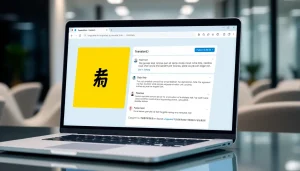Mastering Competitive Intelligence: Strategies for Business Success
Understanding Competitive Intelligence
What is Competitive Intelligence?
Competitive intelligence (CI) refers to the systematic process of gathering, analyzing, and disseminating information about competitors and the competitive environment. It is a strategic tool aimed at improving organizational performance by gaining insights into market trends, competitor behavior, and potential challenges. Unlike illegal or unethical practices of spying or corporate espionage, competitive intelligence focuses on ethical information gathering to inform decision-making. The essence lies in its forward-looking approach, empowering businesses to anticipate market dynamics and respond proactively.
The Importance of Competitive Intelligence in Business
The role of competitive intelligence in modern business cannot be overstated. By leveraging CI, organizations can:
- Identify Opportunities: Market insights can reveal untapped opportunities for product development or entry into new markets.
- Mitigate Risks: Understanding competitive moves allows businesses to develop strategies that preempt potential threats.
- Enhance Strategic Planning: Data-driven insights inform leadership on strategic directions, aligning resources effectively.
- Boost Innovation: Observing competitors can inspire innovative practices, leading to enhanced customer satisfaction.
- Create Competitive Advantages: The ultimate aim of CI is to establish a sustainable competitive edge by staying ahead of rivals.
Thus, integrating competitive intelligence into business strategies has become crucial for organizations that aspire to thrive in today’s dynamic marketplace.
Common Misconceptions about Competitive Intelligence
Despite its importance, several misconceptions about competitive intelligence persist:
- CI is Spying: Many equate CI with unethical practices; however, CI is based on legal and ethical data collection methods.
- CI is Only for Large Companies: Small and medium enterprises can benefit from CI just as significantly, often with less resource investment.
- CI is a One-Time Activity: The reality is that CI is an ongoing process that evolves with market conditions and competitor behavior.
- CI is Just Another Term for Market Research: While related, CI is broader in scope and often more focused on competitor actions than just market trends.
Key Components of Competitive Intelligence
Data Collection Techniques for Competitive Intelligence
The backbone of effective competitive intelligence lies in robust data collection techniques. These methods are essential to gather actionable insights:
- Secondary Research: This involves gathering publicly available data, including market reports, news articles, and competitor websites.
- Surveys and Interviews: Engaging directly with customers and industry experts provides firsthand insights about competitor offerings and market sentiments.
- Social Media Monitoring: Analyzing social media activities can reflect competitor strategies, customer feedback, and emerging trends.
- Web Scraping: Advanced tools can automate the collection of data from various online sources, providing comprehensive insights on competitor activities.
Analysis Tools for Effective Competitive Intelligence
Once data is collected, it needs to be carefully analyzed to derive meaningful insights. Various tools assist in this process:
- SWOT Analysis: A classic tool used to identify strengths, weaknesses, opportunities, and threats relating to competitors.
- Boston Consulting Group Matrix: This helps in understanding market positioning and resource allocation regarding different business units.
- PESTEL Analysis: This framework evaluates political, economic, social, technological, environmental, and legal factors influencing the market landscape.
- Sentiment Analysis Tools: Technologies that analyze consumer opinions from social media and reviews can provide valuable insights into market perception.
Dissemination of Competitive Intelligence Insights
After analysis, it is crucial to disseminate findings effectively within the organization. The insights must reach the relevant stakeholders to inform decisions:
- Reports and Dashboards: Summarizing findings in visually appealing formats that outline key insights and recommendations.
- Workshops and Meetings: Organizing sessions to discuss CI findings with teams across the organization encourages collaborative strategy formulation.
- Real-Time Alerts: Setting up monitoring systems that automatically notify teams of significant competitor changes or market shifts ensures timely reactions.
Implementing Competitive Intelligence in Your Organization
Steps to Build a Competitive Intelligence Framework
Implementing a CI framework requires careful planning and execution. Here are key steps to building an effective CI program:
- Define Objectives: Establish clear goals for what the organization aims to achieve with CI.
- Identify Key Competitors: Determine which competitors are relevant for monitoring based on your market segment.
- Develop a Data Gathering Plan: Outline specific methods for collecting data about competitors.
- Assign Responsibilities: Designate team members or departments responsible for collecting and analyzing CI.
- Establish a Regular Review Process: Create a schedule for regularly reviewing and updating CI findings to ensure information is current and actionable.
Establishing a Competitive Intelligence Team
Building a dedicated team to handle CI efforts enhances the quality and effectiveness of the intelligence gathered. A successful CI team often includes:
- Analysts: Skilled in data collection and analysis, analysts interpret data to generate insights.
- Researchers: Individuals focused on digging deep into various sources of information to gather intelligence.
- Decision-Makers: Senior management or executive team members who can leverage insights for strategic planning.
- IT Specialists: Those who ensure technology and tools used for CI are up to date and functioning optimally.
Best Practices for Continuous Improvement in Competitive Intelligence
To ensure CI remains relevant and effective, organizations should embrace continuous improvement practices:
- Feedback Loops: Establish a mechanism for stakeholders to provide feedback on CI processes and outputs.
- Training Programs: Regularly train team members on new tools, techniques, and methodologies for CI.
- Benchmarking: Compare CI practices against industry standards to discover areas for enhancement.
- Adapting to Changes: Stay flexible and willing to adapt CI strategies based on evolving market conditions or competitor actions.
Competitive Intelligence Metrics and KPIs
Assessing the Impact of Competitive Intelligence Efforts
Developing metrics to evaluate the effectiveness of CI initiatives is essential. Key performance indicators (KPIs) to consider include:
- Market Share Growth: Measuring shifts in market share can indicate whether CI efforts are affecting competitive positioning.
- Lead Conversion Rates: An increase in conversions after implementing CI can signify effective targeting and strategy informed by insights.
- Customer Retention Rates: Monitoring retention can highlight improvements in customer satisfaction due to competitive insights.
- Speed to Market: The time taken to launch new products can be affected by timely competitive intelligence.
Key Performance Indicators for Measuring Success
In addition to impact assessment, it is crucial to track specific KPIs related to the CI process itself:
- Data Accuracy: The percentage of accurate intelligence gathered compared to findings in practice.
- Insights Utilization Rate: How often the insights gathered are used in strategic planning and decision-making.
- Stakeholder Satisfaction: Surveys to measure how well the CI outputs meet the needs of different departments.
- Frequency of CI Updates: The regularity with which CI data is reviewed and refreshed.
Adjusting Strategies Based on Competitive Intelligence Findings
The ability to adapt strategies based on CI findings can set successful organizations apart. Steps include:
- Regular Strategy Reviews: Schedule intervals for evaluating existing strategies against recent CI insights.
- Scenario Planning: Utilize CI findings to simulate different market scenarios and prepare responses.
- Agility in Execution: Maintain flexibility in operational procedures to accommodate strategic pivots based on CI insights.
Case Studies: Success Through Competitive Intelligence
Industry Examples of Effective Competitive Intelligence Usage
Numerous organizations have excelled through effective competitive intelligence practices. For instance:
- Corporations in the tech industry utilize CI to analyze competitor product launches, thereby refining their offerings and ensuring their innovations remain competitive.
- Retail businesses leverage customer sentiment analysis to tailor marketing campaigns and product assortments that align with consumer preferences, significantly enhancing engagement.
- Some pharmaceutical companies use CI efforts in R&D to gauge competitor advancements in drug development, allowing them to adjust their pipelines effectively.
Lessons Learned from Competitive Intelligence Failures
It is equally vital to learn from failures to enhance future efforts:
- Many organizations have suffered due to over-reliance on outdated data, leading to misguided strategies.
- A lack of internal communication about CI findings can result in missed opportunities; thus, clear pathways for dissemination are critical.
- Failing to adjust CI frameworks as market conditions evolve can render the efforts irrelevant, highlighting the need for continuous adaptation.
Future Trends in Competitive Intelligence
The landscape of competitive intelligence is continuously evolving. Key future trends include:
- Integration with AI: Leveraging artificial intelligence for enhanced data analysis and predictive insights will become standard.
- Real-Time CI: The demand for instantaneous insights will grow, necessitating more dynamic data-gathering methods.
- Increased Collaboration: Inter-departmental collaboration on CI efforts will become vital as companies recognize the multi-faceted nature of competitive landscapes.
- Ethical Considerations: As scrutiny increases on ethical data collection, maintaining high standards will be imperative for organizations engaged in CI.














Post Comment